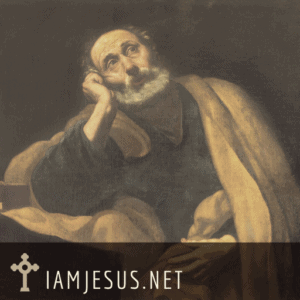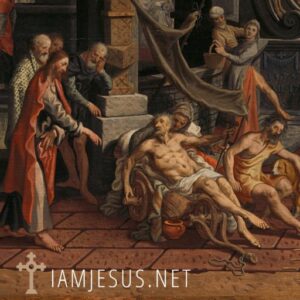St. Teresa of Avila (1515-1582)
St. Teresa of Avila, is known as the reformer of the Carmelite Order. She is a renowned mystical saint of the Church who was born and worked in Spain in the sixteenth century. St. Teresa of Avila lived in a time when her country was becoming a powerful nation of the world. Spain was not only the dominant country of Europe, but also a leader in the discovery of and colonization of America, Africa, and India.
In 1580, two years before the death of Teresa of Avila, Spain and Portugal were united into one kingdom. It was the Golden Age of Spanish culture and wealth. It was also a time of great religious fervor in Spain.

Teresa Sanchez, was born at Avila in old Castile in 1515. Her father, Alphonse Sanchez, married twice, having three children by his first wife and nine children by his second wife, seven sons and two daughters. Teresa was the eldest of these two daughters by the second marriage.
Teresa’s mother died when Teresa was fourteen years old and afterward she developed a devotion to the Virgin Mary. Teresa was very close to her brother Rodriguez, and they used to read and pray together frequently. They became enamored of the Crusades to the Holy Land, a project which fired the imagination of all Christendom in those days. On one occasion, in their desperate schemes to convert the non-believers, they set out together for the Moorish settlements, resolved if necessary to die for the Faith. Fortunately for themselves and for the Faith, however, they were found outside the town by an uncle and brought home.
St. Teresa of Avila’s interests turned to clothes, friends, her looks, and rebelling against her father’s wishes. When she was sixteen her father decided she was out of control and sent her to live at a convent. Though she was not happy with this decision at first, she grew to love it there – due largely in part to her growing love for God. Teresa studied for a while with the Augustinian nuns of Avila, and finally, against her father’s wishes, she entered the Carmelite Order at Avila where she made her profession at the age of 20.
St. Teresa and St. John of the Cross
During the sixteenth century, largely through the efforts of St. Teresa and St. John of the Cross, there was a great reform of ecclesiastical and monastic life. St. Teresa and St. John reformed the Carmelites. Both Teresa and John of the Cross were members of the Order of Our Lady of Mt. Carmel, a religious order which had been founded in 1206 on Mt. Carmel in Palestine.
St. Albert, the Patriarch of Jerusalem gave the Carmelite Order its first monastic rule. During the thirteenth century, when the Carmelites made their first appearance in Europe, they tried to combine the rigorous rule of the hermits of the east with the active and Apostolic missionary zeal of the mendicant orders such as the Franciscans and the Dominicans. As a proposed solution to this conflict, in 1432, the original rule of St. Albert was relaxed or mitigated, as it were, by Pope Eugenius.
Together St. Teresa and St. John of the Cross protested against the relaxation of the ancient Carmelite order. They attempted to bring about the restoration of the cloistered contemplative life. They encountered many obstacles and extreme resistance over a long period of time.
The Carmelite convent where Teresa lived, and the others in her area, were all of the Mitigated Rule. Many ladies from the upper class of society had entered and there were some dubious vocations. The nuns wore silken habits, had their own quarters with the usual comforts of life and could receive as well as entertain visitors and relatives in the parlors of their respective convents. It was more of a “salon-like” existence with erudite conversations on abstruse theological points or political gossip of the day, rather than a “cell-like” manner of life, with the emphasis on prayer, seclusion, and meditation. Certainly the Carmelite convent for women in those days was a far cry the strict enclosure we know today.
St. Teresa's Sufferings
Throughout her entire life, St. Teresa of Avila suffered from numerous illnesses. St. Teresa offered up the sufferings of as an act of love and devotion to God.
Prior to her entrance into religious life and her profession at the age of twenty years, St. Teresa had suffered from an undetermined illness which now increased in its severity. She suffered heart attacks and violent fainting spells which very often deprived her of her senses. As already noted, the Carmelites were not then in strict enclosure, so her father persuaded St. Teresa’s physician to have her removed from the convent for more particular treatment.
At the end of a first year in the convent, her condition became so grave that she was actually thought to be dead. Funeral arrangements were made and she was almost buried alive until her father noted some signs of life. St. Teresa eventually returned to the convent at Avila where she continued to suffer from this strange sickness. It was almost three years before she fully recovered, and during this time she was so crippled that she was completely bent over.
St. Teresa's Mystical Experiences
After her recovery, St. Teresa began to experience more and more a complete union with God. She experienced many visions of the Holy Eucharist, the Blessed Virgin, St. Joseph, and other saints. She frequently experienced ecstatic trances in her mystical union with God. She received the gift of levitation, and during these times, according to very reliable witnesses, her body would actually rise from the ground, in spite of her pleas to have others hold her down.
This would often happen during the Holy Sacrifice of the Mass, or when she was about to receive Holy Communion. In spite of her illness and her unusual life, however, St. Teresa did not forget her great aim, and in the year 1562, she set out to reform of the Carmelite Order.
One of the most famous miracles attributed to her is similar to the miracle of Jesus and Lazarus. The wall of a building fell on Teresa’s young nephew and he was crushed. Apparently dead, he was brought to Teresa. She held her little nephew in her arm and prayed deeply. Minutes later, the boy came back to life. This miracle, in fact, was presented at Teresa’s canonization.
Many other miracles occurred in St. Teresa’s life, but it can be argued that the greatest miracle was her own conversion. In her autobiography, she once said “The possession of virtuous parents who lived in the fear of God, together with those favors which I received from his Divine Majesty, might have made me good, if I had not been so very wicked.”
St. Teresa Fulfills the Will of God
There were many disappointments through disapproving superiors who regarded St. Teresa as a religious fanatic. As much as she suffered, however, St. Teresa never regarded herself as a martyr. She had an extraordinary dry sense of humor, and could laugh things off.
St. Teresa suffered a great deal during her years of attempted reformation, but following the advice a Confessor, she habitually prayed the “Veni Creator” every day for guidance from the Holy Ghost. Her motto was: “to die or to suffer,” and she suffered a lot. The Mitigated Carmelites wanted to send her to the Indies just to get rid of her.
Finally after superhuman efforts, and seemingly insurmountable obstacles, Teresa succeeded in her project. She set up a small convent with a few sisters and there they observed the original strict rule of the Carmelite Order. She lived to established in Spain sixteen convents of the Reformed or Strict Observance for Women, and fourteen monasteries for the Carmelite Friars, founded with the aid of St. John of the Cross. By a Brief from Rome in 1577, during the life of both Teresa and John, the separation was sanctioned, and the result of this reform was the establishment of the Carmelites into two separate divisions, the Calced or “the Mitigated”, and the Discalced or the “Carmelites of the Strict Observance”
“The surest way to determine whether one possesses the love of God is to see whether he or she loves his or her neighbor. These two loves are never separated. Rest assured, the more you progress in love of neighbor the more your love of God will increase.”
St. Teresa of Avila
St Theresa of Avila’s Feast Day is October 15. She is the patron saint of Spain, of lace makers, and against headaches and sickness.
Read “Interior Castle” here.
Prayers of the Saints

Mother Teresa of Calcutta Prayer for Priests
“Perpetual Eucharistic Adoration with exposition needs a great push. People ask me: ‘What will convert America and save the world?’ My answer is prayer. What

Prayer for Divine Transformation from Within by St Faustina
The Lord Jesus Christ gave St. Faustina Kowalska a beautiful gift and through her obedience to Him she gave a message of God’s mercy to the world. Jesus revealed to Saint Faustina the way of Christian perfection based on trust in God having mercy on our neighbors.

Prayer of Saint Francis of Assisi before the Crucifix
Saint Francis of Assisi had a deep devotion to Jesus in adoration. When he began his ministry of rebuilding the church he entered a ruined church and heard Jesus speak to him from the crucifix.

Beautiful Prayer for Priests by Saint Thérèse of Lisieux
This beautiful prayer for priests was written by St. Thérèse of Lisieux, and is a wonderful way to support our clergy while we are praying to Jesus in the adoration chapel.

Prayer to St. Peter the Apostle
Pray this prayer to St. Peter the Apostle, the first pope, who Jesus raised to high authority even though he denied Him three times on Good Friday.

Prayer to St. Michael the Archangel
This prayer to St. Michael the Archangel was written by Pope Leo XIII and published in the Roman Raccolta on July 23, 1898. This prayer to St. Michael the Archangel was recited after Low Mass from 1886 to 1964 in the Catholic Church.
More Biographies of Mystical Saints

St. Veronica Giuliani: Stigmatist and Mystic
St. Veronica Giuliani, a stigmatist and mystic, had a deep devotion to the Sacred Heart of Jesus and was known as a victim soul.

St. Thérèse of Lisieux, the Little Flower
St. Thérèse of Lisieux was a beautiful soul who longed to do great things for God but soon learned that the “little way” was most efficacious and pleasing to Him. She is a doctor of the Church.

St. Teresa of Avila, Doctor of the Church
St. Teresa of Avila is a mystical saint who has had the most profound impact on the world through her writings on the spiritual life. She was graced with many mystical gifts including transverberation.

St. Peter Julian Eymard, Saint for the Eucharistic Revival
Saint Peter Julian Eymard, the founder of the Congregation of the Blessed Sacrament, was deeply transformed by the Real Presence of Jesus Christ in the Eucharist.

St. Mary Magdalen de Pazzi, the Passion Flower of the Eucharist
St. Mary Magdalen de Pazzi experienced many ecstasies while suffering a grave illness. Throughout her suffering she drew close to the Divine Heart of Christ.

St. John of the Cross, Doctor of Divine Love
Read the biography of St. John of the Cross, a mystical saint from Spain who was a friend of St. Theresa of Avila.

St. Catherine of Siena Sets the World on Fire in the Midst of Plague
St. Catherine of Siena was born at the start of bubonic plague, in Siena, Italy on March 25, 1347. She is an extraordinary mystical saint, stigmatist, leader, and peace maker. St. Catherine was in the Third Order of St. Dominic religious society.

Concepción Cabrera de Armida, known as Blessed Conchita
Blessed Concepción Cabrera de Armida, widely known as Blessed Conchita, is a Mexican saint for wives and mothers with a deep devotion to Jesus in the Eucharist.







